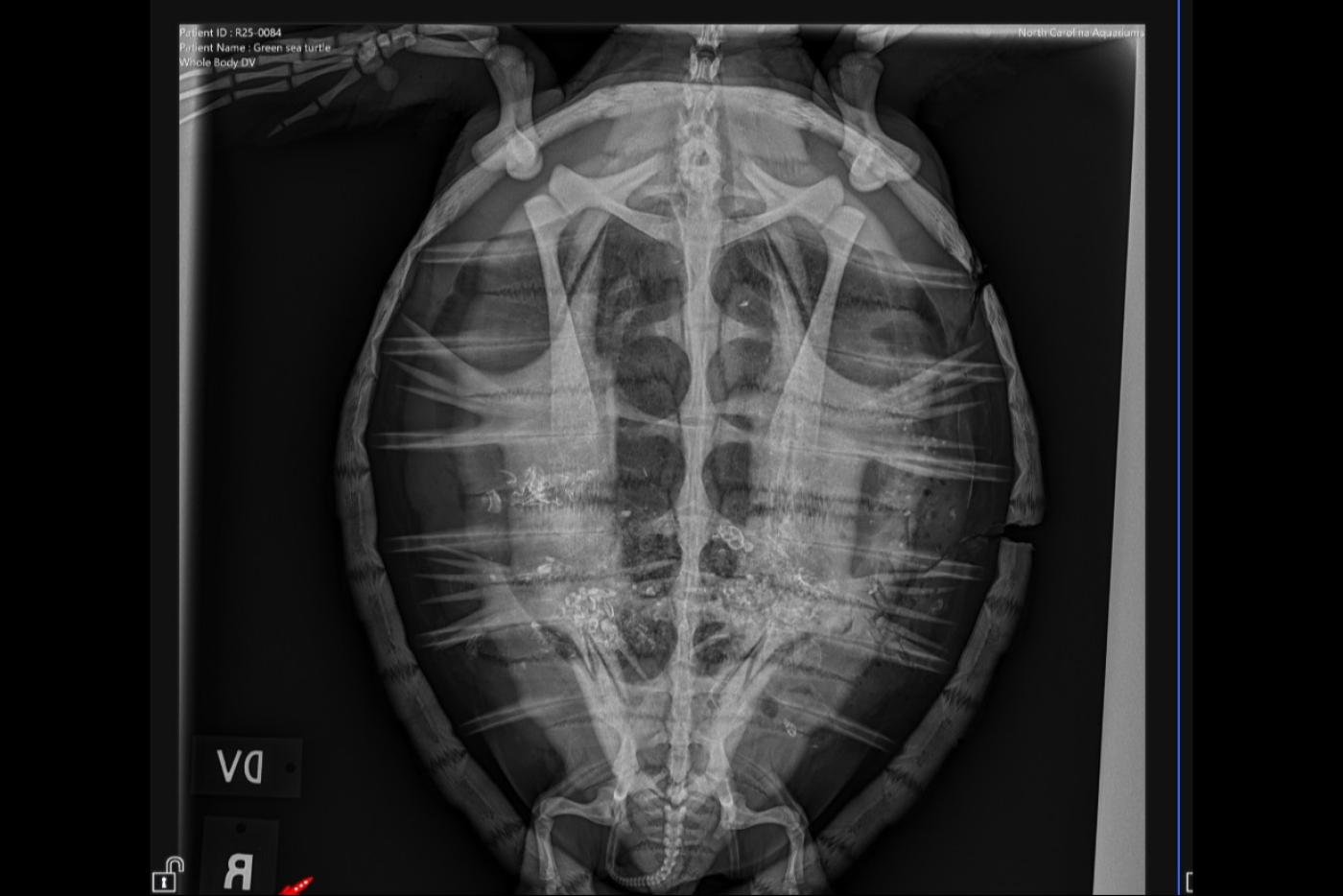The newest sea turtle patient at the N.C. Aquarium on Roanoke Island is quickly capturing hearts across the Outer Banks. In late June a small juvenile green sea turtle, nicknamed “Lucky Duck,” arrived at the Sea Turtle Assistance and Rehabilitation (S.T.A.R.) Center at the N.C. Aquarium on Roanoke Island with visible injuries from an apparent shark bite. The mission of the Aquarium, to inspire appreciation and conservation of our aquatic environments, is lately exemplified by Lucky’s Duck’s survival and rehabilitation. The Aquarium is part of the N.C. Department of Natural and Cultural Resources.
On June 25 a radiograph revealed a fractured carapace and additional health complications for Lucky Duck. Upon closer inspection, Aquarium veterinarians and sea turtle aquarists at the S.T.A.R. Center discovered Lucky Duck’s intestinal tract was flooded with ingested micro-plastics. To demonstrate the severity and amount of plastic Lucky Duck ingested, the striking variety of defecated debris was placed on display at the Aquarium to raise public awareness about the damage single-use plastic can cause for wildlife.
Contending with difficulties caused by both natural and man-made encounters, Lucky Duck came by its nickname naturally having survived these difficulties and being rescued oceanside by a visitor to the Outer Banks by notifying Aquarium partner, N.E.S.T. (Network for Endangered Sea Turtles).
Since arriving at the Aquarium, Lucky Duck has been on a steady diet of protein and lettuce—roughage—to help it defecate the ingested plastic. When plastics enter a sea turtle’s environment, it presumes the plastics to be part of the environment. Plastic grocery bags in water, for example, appear as jellyfish to a sea turtle. A sea turtle with a belly full of micro-plastics will expend energy trying to digest the plastic, which wastes valuable nutrients and weakens the sea turtle. At the Aquarium, Lucky Duck is receiving quality food and nutrients to restore its health, which is especially important as it recovers from trauma wounds due to the apparent shark bite. Lucky Duck is healing nicely, swimming, and navigating excellently. The Aquarium is pleased to share this progress report with the public.
Responding to the impact of Lucky Duck’s story, Leslie Vegas, husbandry curator at the Aquarium said, “Working with the team that cares for the animals is so rewarding, whether the animals are rehab patients or permanent residents at our facility. Lucky Duck’s story is one of many that can inspire folks to appreciate all the animals we are lucky enough to care for at the Aquarium. They each have unique stories that teach us the importance of conservation work.”
The S.T.A.R. Center, founded at the Aquarium in 2014, rehabilitates rescued sea turtles year-round. In recent years, sea turtle patients have been treated at the Aquarium for assorted problems, including cold-stunning, eye injuries, kidney failure, pneumonia, frostbite, infections, and injuries from boat strikes and ingested fishing hooks. When sea turtle patients are cleared by Aquarium veterinarians, the Aquarium releases recovered sea turtles back into their natural environment. Sea turtles have been released by the Aquarium oceanside, offshore into the warm waters of the Gulf Stream, and into the Croatan Sound—the Aquarium’s aquatic backyard. Dedicated in 1976, the Aquarium is celebrating its 50th anniversary in 2026.
About the North Carolina Aquarium on Roanoke Island
Located on the Outer Banks in Manteo, N.C., the N.C. Aquarium on Roanoke Island is part of N.C. Aquariums, which includes four attractions along North Carolina’s coast and is a division of the N.C. Department of Natural and Cultural Resources. The 63,000 square-foot facility on 16 acres overlooks the Croatan Sound and houses over 2,200 animals. Over 319,000 guests visit the Aquarium each year to see the 285,000-gallon "Graveyard of the Atlantic" shark and ocean habitat, visit the Sea Turtle Assistance and Rehabilitation (S.T.A.R.) Center, and learn why North Carolina's waterways are so special. As an educational attraction, the mission of N.C. Aquariums is to inspire appreciation and conservation of our aquatic environments. The Aquarium is open from 9 a.m. to 5 p.m. every day except Thanksgiving and Christmas. For more information, please visit www.ncaquariums.com/roanoke-island.
About the North Carolina Department of Natural and Cultural Resources
The N.C. Department of Natural and Cultural Resources (DNCR) manages, promotes, and enhances the things that people love about North Carolina – its diverse arts and culture, rich history, and spectacular natural areas. Through its programs, the department enhances education, stimulates economic development, improves public health, expands accessibility, and strengthens community resiliency.
The department manages over 100 locations across the state, including 27 historic sites, seven history museums, two art museums, five science museums, four aquariums, 35 state parks, four recreation areas, dozens of state trails and natural areas, the North Carolina Zoo, the State Library, the State Archives, the N.C. Arts Council, the African American Heritage Commission, the American Indian Heritage Commission, the State Historic Preservation Office, the Office of State Archaeology, the Highway Historical Markers program, the N.C. Land and Water Fund, and the Natural Heritage Program. For more information, please visit www.dncr.nc.gov.

